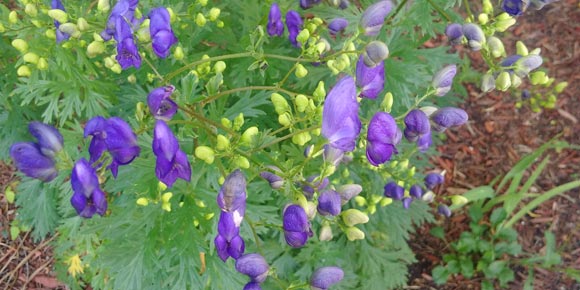In our cold climate, garden choices often revolve around what is in bloom during the garden market season. We emerge from dull winter cocoons all eager for colour and we tend to get seduced by every pretty blossom we see in the garden centres. Because they are blooming when we shop, our choices are often all about spring and early summer. It is much harder to visualize and plan for those flowers that don’t come into their own until later in the season.
Late-blooming annuals
There are many late annuals that don’t really shine until later in the season. This includes the wonderful salvias that tend to bloom from July onward. One of my favourites is Salvia farinacea ‘Victoria Blue’ with its tall, dark blue spikes, or Salvia verticillata which is purple. Both will bloom until frost and they make excellent dried bouquets. Less showy, but delightful nonetheless, is Salvia guaranitica ‘Black and Blue’ which has bottle-blue flowers presented on black calyxes. Spectacular!
However, most fall flowers are anything but blue. In the latter part of summer and into autumn, blossoms present mainly in red, yellow, orange, mauve and even purple. The chrysanthemums come easily to mind, both the annual and perennial varieties. Their jewel-like tones brighten dull days, but it is important to remember that annual chrysanthemums are very tender and will succumb to a light frost. Well worth growing though is a beautiful heritage perennial, Clara Curtis, which blooms late into fall with glorious clumps of single pink blossoms.
Lavender, white, pink and purple annual asters are easy to grow from seed and are extremely showy in the fall garden. Peony flowered, pompon, and chrysanthemum flowered all describe their many forms.
Ornamental kale is a great choice for its ruffled grey-green and purple leaves, which will look good even after a snowfall as long as it doesn’t get too far below zero.
Fall is also the time when all the grasses come into their own. Nothing is more glorious than to see the pretty seed heads of Pennisetum ‘Rubrum’ waving in the breeze scattering light in the late afternoon sun.
Zinnias now make their spectacular debut, flaunting their stunning colours at almost every height and in all the lovely reds, whites, pinks, yellows, mauves and golds in single and double form.
As the days get cooler, pansies also revive. It’s a good idea to tuck summer wilting pansies out of the sun and in a semi shady place until fall, then bring them back into the sun and watch them rejuvenate in all their spring glory.
There are also some not-so-common annual plants that will add sparkle to the fall garden. As the days get shorter, lisianthus (Eustoma) will steal the show with its rose-like blossoms that come in every shade of blue, purple, pink and white, but also in green, picotee (white with blue or purple edges) and now some yellow and peach shades.
Kniphofia or torch lily (red hot poker to some) will send blazing gold and red spires up in the latter part of the year. Crocosmia has stunning scarlet flowers rising from sword-like foliage in later summer.
Also on your list must be sunflowers, canna lilies, and cleome which just does not quit!
The fall perennial garden
Taking even more careful planning are the late blooming perennials.
Near the top of my list would be the ever changing Echinacea which now comes in so many varieties that you could populate your whole garden with them. Look for their blossoms in late July to August.
Joe Pye Weed (Eupatorium maculatum) also rewards in fall with its great umbels of pink with some varieties reaching as high as seven feet into the air. Consistently moist soil is all it takes to coax this stunner into bloom to feed late butterflies and other pollinators.
Gaillardia or blanket flower shines though red and yellow. A lovely little mounding varieity with trumpet-shaped petals is Gaillardia grandiflora, which just does not know when to stop blooming.
False sunflower shows its sunny brightness in late July and carries on blooming for weeks. Its Latin name is Heliopsis helianthoides, which shouts sunshine and that is just what it will bring to a dry shady spot in the garden.
Goldenrod has a bad, but undeserved reputation in some quarters, as a sneezemakers, but this is just not true; its pollen is too heavy to float. — it’s ragweed which does the evil deed. Some wild varieties of goldenrod can also be invasive but there are clump forming varieties that are well behaved.
Speaking of sneezemakers, sneezeweed (Helianthus autumnale) is one of the prettiest flowers in the garden. Its perky bright red, yellow or orange blossoms are set off by cone-shaped centres that act as bee magnets. In case you are wondering, its dried, the pollen from nearly mature flowers were used to in snuff and to treat colds and headaches.
Monkshood (Aconitum) is another fall friend which brings a startling blue to the garden. There is also a pictoee variety with white blossoms edged in deep blue.
Dorothy dobbie is the owner/publisher of Manitoba Gardener magazine. Listen to Dorothy’s garden show on Nostalgia Radio, CJNU 93.7 FM Sunday mornings at 8:00. If you would like to subscribe the Manitoba /gardener, call Jane at 204 940 2700 or go to www.localgardener.net



